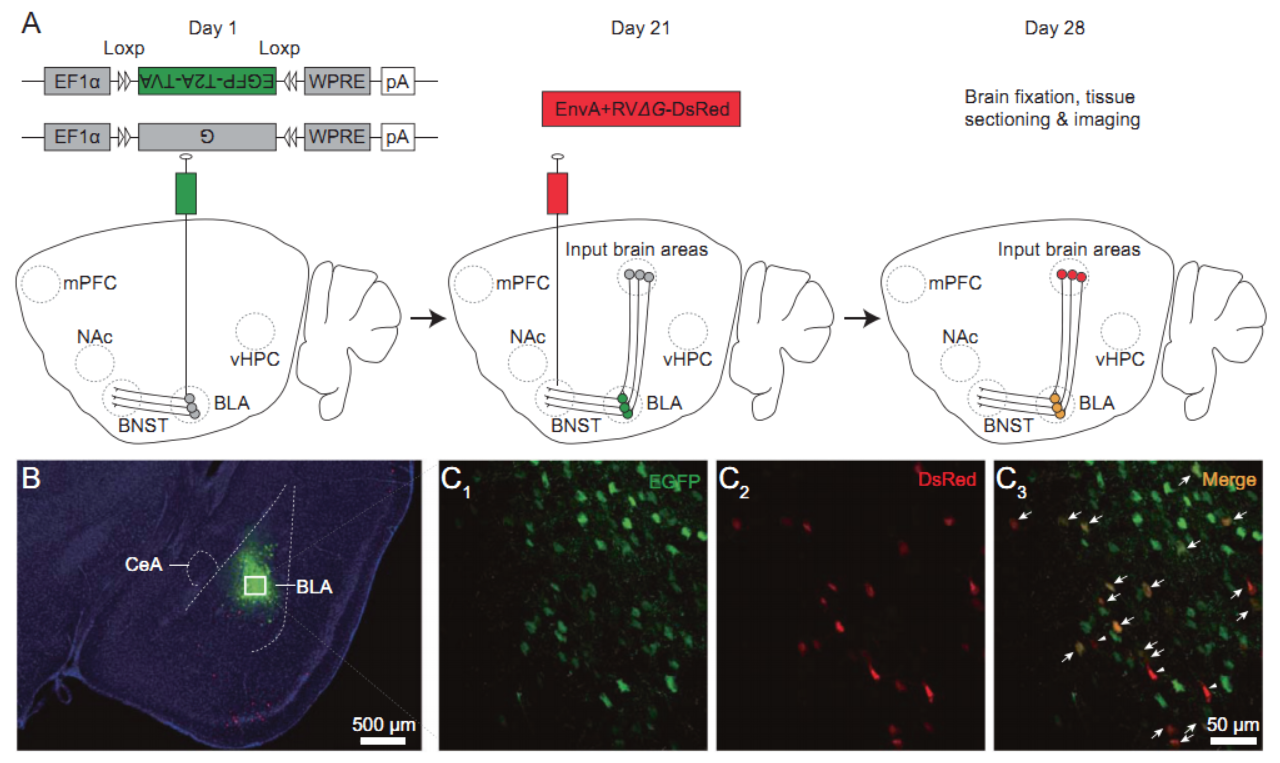AAV- DIO-EYFP was used for anterograde axon tracing. (From
BrainVTA)
The viruses used in this article from BrainVTA are in the table below
|
Control |
PT-0012 AAV-EF1α-DIO-EYFP-WPRE-pA |
Limeng Huang, Yiwen Chen, Sen Jin, Li Lin, Shumin Duan, Ke Si, Wei Gong, J Julius Zhu
Pub Date: 2021-08-16,
DOI: 10.1038/s41586-022-04668-3,
Email: sales@brainvta.com
The amygdala, one of the most studied brain structures, integrates brain-wide heterogeneous inputs and governs multidimensional outputs to control diverse behaviors central to survival, yet how amygdalar input-output neuronal circuits are organized remains unclear. Using a simplified cell-type- and projection-specific retrograde transsynaptic tracing technique, we scrutinized brain-wide afferent inputs of four major output neuronal groups in the amygdalar basolateral complex (BLA) that project to the bed nucleus of the stria terminals (BNST), ventral hippocampus (vHPC), medial prefrontal cortex (mPFC) and nucleus accumbens (NAc), respectively. Brain-wide input-output quantitative analysis unveils that BLA efferent neurons receive a diverse array of afferents with varied input weights and predominant contextual representation. Notably, the afferents received by BNST-, vHPC-, mPFC- and NAc-projecting BLA neurons exhibit virtually identical origins and input weights. These results indicate that the organization of amygdalar BLA input-output neuronal circuits follows the input-dependent and output-independent principles, ideal for integrating brain-wide diverse afferent stimuli to control parallel efferent actions. The data provide the objective basis for improving the virtual reality exposure therapy for anxiety disorders and validate the simplified cell-type- and projection-specific retrograde transsynaptic tracing method.

Figure 1. Neuron- and projection-specific retrograde transsynaptic tracing of brain-wide BLA inputs.
Using a simplified cell-type- and projection-specific retro-grade transsynaptic tracing technique, the authors systematically and quantitatively analyzed afferent and efferent connections of BNST-, vHPC-, mPFC- and NAc-projecting neurons in the primary amygdalar nucleus group, the basolateral complex (BLA). The analysis reveals that all projecting BLA neurons receive a heterogeneous array of brain-wide afferents with varied input weights and predominant representation of contextual information. Remarkably, BNST-, vHPC-, mPFC-and NAc-projecting BLA neurons receive the brain-wide afferents with virtually identical origins and input weights. The amygdalar BLA afferent and efferent patterns immediately suggest an input-dependent and output-independent anatomical organizational design, which seems to be ideal for integrating brain-wide diverse afferent stimuli to control parallel efferent behavioral actions.
BrainVTA offers viral vector construction & virus packaging services for AAV, LV, RABV, PRV, HSV and VSV that help researchers explore questions about genes, neurons, circuitry structure, function of brain network, mechanism and treatment of diseases.
If you have any needs, just email us at
sales@brainvta.com.
